This paper introduces step by step the production method of asparagus bonsai and how to maintain it.
Asparagus, also known as Yunpiansong, Tiandong, Yunzhu, is named asparagus only because its leaves are soft, green all the year round, branches are like bamboo, and posture is elegant and unrestrained. Its leafy branches are slender and beautiful, dense like feathers, green clouds layer upon layer, elegant plant shape, unique charm, deeply loved by people, is a famous indoor ornamental flower. So, how should asparagus bonsai be raised?
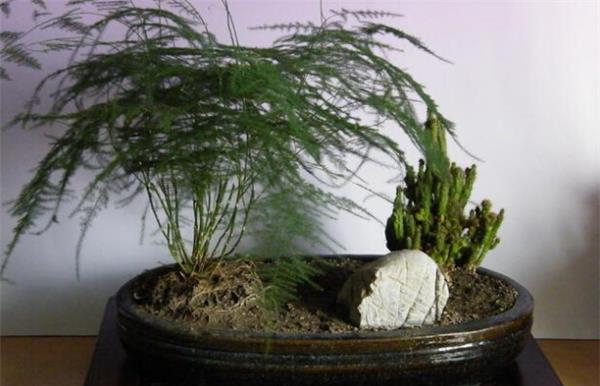
The modeling method of bonsai
1. Tower type: choose 2-3 tall and straight and beautiful stems as the main peak, pick off each growing point on the stem, and set the plant height as 30-35 cm. The remaining branches and new stems should not be higher than the main peak. For new buds, the thickness of their stems can be used to determine whether or not to remove the growing point. If the stem is thicker than the main peak, it should be removed, and if it is thinner than the main peak, it is not necessary to pick and let it grow. At the same time, it is necessary to adjust the plant shape continuously by using the object shielding method and its own phototaxis.
2. Double-cluster style: plant two asparagus trees, one high and one low, in the basin, the high one is about 30 square meters, and the low one is about 18 meters. During the growth period, it can be shaped like a tower asparagus.
3. Natural style: asparagus is planted in the basin randomly and naturally, and the main plant type is the natural growth of asparagus. The basic methods such as picking off the growing point, covering and making use of its phototaxis are still used to stretch the branches and leaves and give people a natural aesthetic feeling.
Shaping method of asparagus
Due to the rapid growth of asparagus, the small and beautiful shape is often not sustainable, so it must be reshaped as follows.
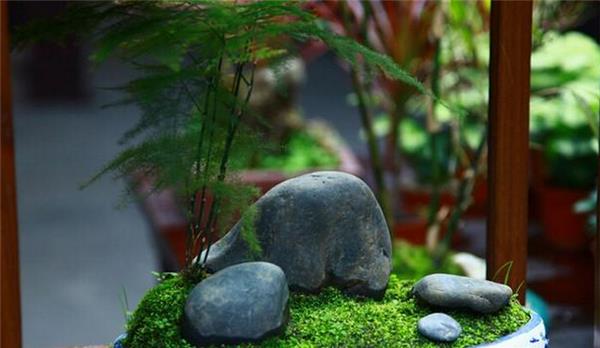
1. Pot control method: the ratio of flowerpot size to plant height should be 1:3, which can limit the growth of root system and keep the plant size unchanged.
2. Growth point: when the new bud grows to 2-3 cm, the removal of the growth point can promote the regeneration of branches and leaves on the stem, and control its non-growing vines, so that the branches and leaves flatten out, and the plant shape continues to plump.
3. Phototaxis: turning the direction of the flowerpot at the right time can modify the growth shape of branches and leaves and keep the plant type unchanged.
4. Object shielding method: that is, using a piece of hard paper to press the branches and leaves or cover the sun, so that when the branches and leaves are growing, the stems will turn or bend when they encounter objects, so as to achieve the purpose of modeling.
Explanation of bonsai production
Material selection: choose one asparagus with high 20cm, two asparagus with high 10cm, irregular white marble shallow basin and its supporting frames, some mountains and rocks with high 10cm, and appropriate amount of culture soil and moss.
Bonsai modeling: first spread a thin layer of cultivation soil in the marble shallow basin, plant the tallest asparagus, curved branches and leaves to the right end of the basin, plant the second height asparagus on the left side of the first asparagus not far from the back of the basin, and then plant the shortest asparagus at the junction of the pot length of 1jump 2 and 2bank 3, and the curved branches and leaves of asparagus should also be to the left, in order to achieve the coordination and unity of the three asparagus. Then take a look from a distance and adjust the position of asparagus in the basin to achieve natural beauty.
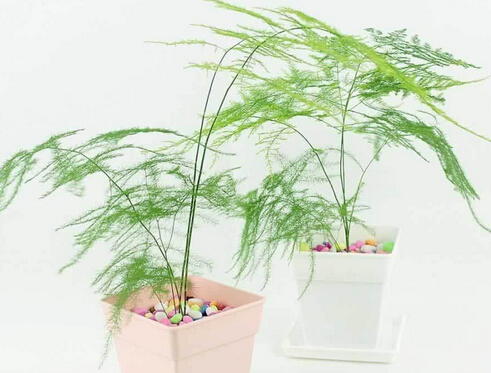
Point stone moss: asparagus branches thin and curved, is a soft performance, plus irregular white marble basin is also curved around, this scene is more flexible, masculine insufficient. The best scenery should be strong and soft. In the basin appropriate to the right after the position to put two tall and straight rocks, rock quality, left and right side line is straight, is just the performance. On the basin surface culture soil, cover a layer of moss to achieve the artistic effect of greening. Spray asparagus and moss with clean water and moisten the culture soil.
Asparagus is a perennial evergreen herb, like warm, humid and semi-sunny environment, afraid of cold, afraid of exposure. It is necessary to make the bonsai of asparagus green and highly ornamental. So, what are the points for attention of asparagus bonsai?
(1) place: in North China, asparagus bonsai can be maintained indoors or in closed balconies all the year round. Pay attention to the flow of air.
(2) Illumination: asparagus prefers a warm, humid and shaded environment and is not resistant to strong light. Early spring, late autumn and winter can be exposed to sunlight. Shade or see scattered light at other times.
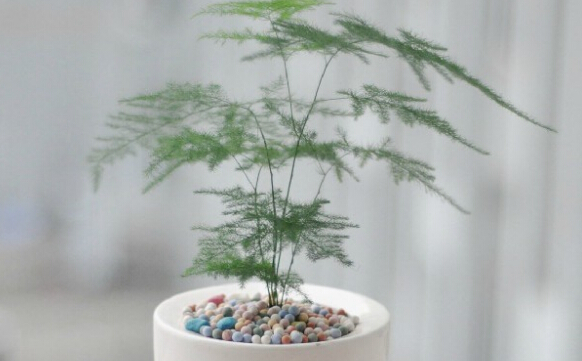
(3) temperature: asparagus is a shade-loving plant, likes a warm and humid climate, can not bear cold, but also afraid of summer heat. The requirements of light conditions are relatively strict, neither year-round shade, but also can not withstand the sun exposure, exposure in the hot sun for half a day will be withered and yellow. Therefore, it is appropriate to migrate asparagus to indoor culture and grow under scattered light to avoid direct sunlight. Keep the soil fertile, draining and breathable, and keep the indoor temperature above 5 ℃ in winter in order to make it safe through the winter.
(4) watering: during the growing period of late spring, summer, drought and autumn, the basin soil can be moist properly, and the water injury evaporation is less in winter, so it is necessary to water less, as long as the basin soil is kept moist.
(5) fertilization: during the growing period, thin organic liquid fertilizer can be applied once a month. Fat will promote the branches and leaves of asparagus to grow, but destroy the shape. Don't fertilize in winter.
(6) pruning: asparagus grows fast, and new branches often grow from the roots during the growing period, and the old stems and leaves turn yellow with a long time. In order to maintain the emerald green stems and leaves and graceful posture of asparagus, old branches, ungrown branches and leaves that affect the shape should be often cut off.
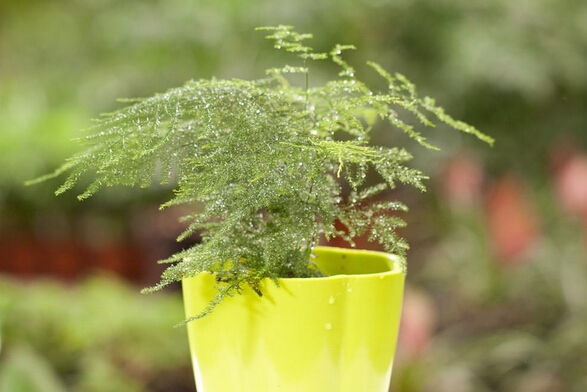
Asparagus is a perennial evergreen herb, like warm, humid and semi-sunny environment, afraid of cold, afraid of exposure. In order to make asparagus bonsai green and highly ornamental, it is necessary to maintain it according to its growth habits, which can be referred to the culture methods of asparagus. The above is the introduction of the relevant information about asparagus bonsai introduced by the editor. I hope it can help you.
Only when the indoor temperature is controlled above 5 ℃ in winter can it pass the winter safely.
(4) watering: during the growing period of late spring, summer, drought and autumn, the basin soil can be moist properly, and the water injury evaporation is less in winter, so it is necessary to water less, as long as the basin soil is kept moist.
(5) fertilization: during the growing period, thin organic liquid fertilizer can be applied once a month. Fat will promote the branches and leaves of asparagus to grow, but destroy the shape. Don't fertilize in winter.
(6) pruning: asparagus grows fast, and new branches often grow from the roots during the growing period, and the old stems and leaves turn yellow with a long time. In order to maintain the emerald green stems and leaves and graceful posture of asparagus, old branches, ungrown branches and leaves that affect the shape should be often cut off.

Asparagus is a perennial evergreen herb, like warm, humid and semi-sunny environment, afraid of cold, afraid of exposure. In order to make asparagus bonsai green and highly ornamental, it is necessary to maintain it according to its growth habits, which can be referred to the culture methods of asparagus. The above is the introduction of the relevant information about asparagus bonsai introduced by the editor. I hope it can help you.
- Prev

When does the primrose bloom? what is the color of the primrose?
When does the primrose bloom? what is the color of the primrose?
- Next

Reveal the production steps of red maple bonsai how to raise red maple bonsai well
Reveal the production steps of red maple bonsai how to raise red maple bonsai well
Related
- Wuhan Hospital Iron Tree Blooming Result Was Instantly Frightened by the Gardener Master
- Which variety of camellia is the most fragrant and best? Which one do you like best?
- What is the small blue coat, the breeding methods and matters needing attention of the succulent plant
- Dormancy time and maintenance management of succulent plants during dormancy
- Minas succulent how to raise, Minas succulent plant pictures
- What are the varieties of winter succulent plants
- How to raise succulent plants in twelve rolls? let's take a look at some experience of breeding twelve rolls.
- Attention should be paid to water control for succulent plants during dormant period (winter and summer)
- Watering experience of twelve rolls of succulent plants
- Techniques for fertilizing succulent plants. An article will let you know how to fertilize succulent plants.

